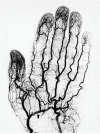Functional Vascular Anatomy of the Brain
- PMID: 28966305
- PMCID: PMC5709711
- DOI: 10.2176/nmc.ra.2017-0030
Functional Vascular Anatomy of the Brain
Abstract
Functional vascular anatomy is the study of anatomy in its relation to the function that figures out the normal and pathological vascularization of the brain and spinal cord. The mechanism of anatomical variations (e.g. fenestration of the basilar artery, persistent primitive trigeminal artery, and aberrant subclavian artery) can be explained according to the embryological development of the cardiovascular system. The most developmental process is common among the species of the vertebrates from the fish to the mammalian in the early phase of embryo. Thus, it is possible to deduce the reasons of vascular variants in terms of phylogeny. Such an embryological parallelism like the comparative anatomy provides the new insights into the nature of our vascular system. In addition, learning more about the hemodynamic consequence may help to realize the underlying physiopathology of cerebral arterial remodeling and stroke in patients with these vascular variants. This perception may facilitate better understanding of the vascular pathologies and lead to the appropriate decision making not only in the diagnostic work, but also in the interventional procedures. The aim of this study is to introduce the meanings of functional anatomy in the clinical application of vascular diseases and anomalous of the central nervous system.
Keywords: balloon occlusion test; collateral circulation; embryology; functional vascular anatomy; hemodynamic tolerance; phylogeny.
Conflict of interest statement
I declare that I have no conflict of interest.
Figures







References
-
- Lasjaunias P, Berenstein A, ter Brugge KG: Clinical Vascular Anatomy and Variations. Berlin, Heidelberg, Springer Berlin Heidelberg, 2001.
-
- Sloffer CA, Lanzino G: Historical vignette. Dominique Anel: father of the hunterian ligation? J Neurosurg 104: 626– 629, 2006. - PubMed
-
- Padget DH: The development of the cranial arteries in the human embryo. Contr Embryol 32: 205– 261, 1948.
-
- Black SP, Ansbacher LE: Saccular aneurysm associated with segmental duplication of the basilar artery. A morphological study. J Neurosurg 61: 1005– 1008, 1984. - PubMed
Publication types
MeSH terms
LinkOut - more resources
Full Text Sources
Other Literature Sources

